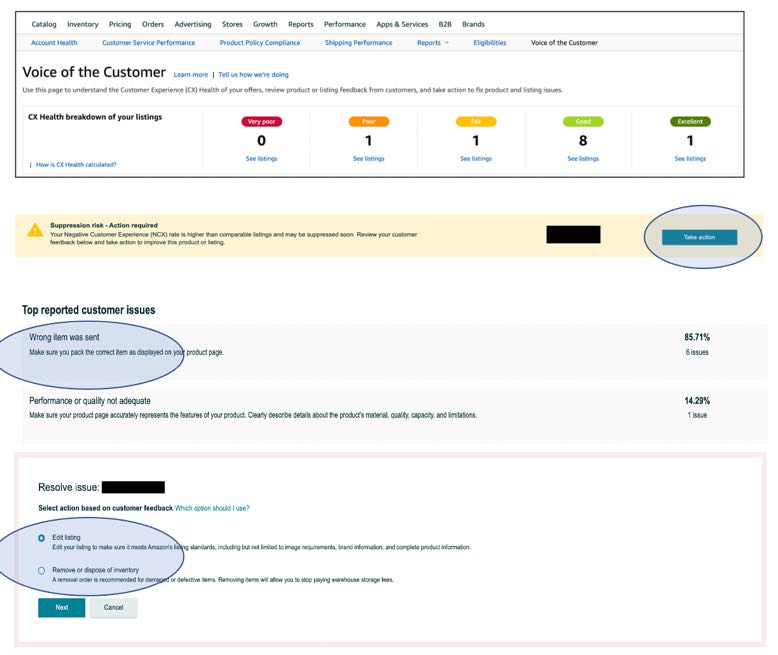Amazon’s new A10 search algorithm ranks organic results, in part, on the “health” of a brand. In this post, I’ll address the Amazon Brand Health initiative, its key metrics, and its effects on marketplace sellers.
Amazon tracks three broad metrics “to help brands be successful and meet [its] customer experience standards”:
- Price Competitiveness,
- Prime Eligibility,
- In-stock Rate.
But beyond those three, brands should also consider:
- Account Health,
- Voice of the Customer.
Brand Dashboard
Navigate to the Brand Dashboard from the Brands tab in Seller Central. This is where Amazon displays the three primary metrics of Price Competitiveness, Prime Eligibility, and In-stock Rate. The Brand Dashboard also includes links to Customer Reviews, Brand Analytics, Manage Your Experiments, and Search Terms Optimizer.

The Brand Dashboard displays the three primary metrics of Price Competitiveness, Prime Eligibility, and In-stock Rate, as well as links to Customer Reviews, Brand Analytics, Manage Your Experiments, and Search Terms Optimizer. Click image to enlarge.
Amazon monitors all of these metrics. The most important is Price Competitiveness.
Price Competitiveness. Amazon rewards the lowest price among major national retailers. If your price is higher, Amazon will take down the listing until you match or beat the lowest offer.
Amazon’s priority is to provide the best online price, not the profitability of the seller.
To avoid Price Health alerts, Amazon recommends enrolling in pricing automation, with two options:
- Automate Price adjusts prices automatically. Sellers can enroll ASINs and trust Amazon’s automation to keep their pricing current based on other offers and pre-defined rules. Automate Price will make pricing decisions for you and protect your items from deactivated. This can be good or bad for the seller, in my experience. The key is to have a solid understanding of a product’s cost, availability, and other economics.
- Sold by Amazon is a new option for sellers. It is by invite only wherein Amazon sets the prices of FBA products. Sold by Amazon allows for a “Minimum Gross Proceeds” threshold. But it’s unclear who determines it: the seller or Amazon. SBA listings will state, “Ships from and sold by Amazon.com.”
In my experience, however, manufacturers and brands should consider additional options to maintain competitive price and profitability, including:
- MAP. Brands should set a Minimum Advertised Price with everyone who sells their products online. Price consistency and control across all retailers is essential — including temporary price reductions. Know how your resellers are representing your brand.
- Product configurations specific to Amazon with unique GTINs (global trade item numbers) simplifies price comparisons for bundled goods.
Prime Eligibility is the frequency of a product being eligible for Prime in the previous 30 days. A product that was out of stock for any length is not Prime eligible. Products are eligible for Prime if they (i) ship on-time 99 percent of the time, (ii) use Amazon-approved carriers, and (iii) have a cancellation rate lower than 0.5 percent.
In-stock Rate. Out-of-stock goods hurt Amazon’s traffic and sales. The In-stock Rate is the percentage of page views to replenishable branded items in the last 30 days.
Related to the In-stock Rate is the “Inventory Performance Index” for FBA sellers. Amazon now limits inventory replenishment for FBA goods. IPI takes sell-through rate, excess inventory, and other factors into account. Amazon restricted restocks at the beginning of the pandemic. The restrictions have continued, presumably in anticipation of higher demand. FBA sellers need to send replenishments to FBA promptly to maintain sales.
Account Health
The Account Health page is accessible from the “Performance” tab of the main Seller Central navigation. Here, you can view metrics related to customer service, policy compliance, and shipping performance, if applicable.

The Account Health page contains metrics related to customer service, policy compliance, and shipping performance, if applicable. Click image to enlarge.
The Order Defect Rate is the percentage of orders that have a defect. Amazon defines a defect as a product that received negative feedback, an A-to-Z claim, or a credit card chargeback. Sellers can avoid this by communicating appropriately with customers when questions arise. Never let a problem become an A-to-Z claim. Amazon requires sellers to maintain an Order Defect Rate below 1 percent. Otherwise, Amazon will close the account.
I have seen many accounts shut down because of poor customer service. If you cannot resolve a customer’s issue, refund the purchase price before it becomes an A-to-Z claim. Amazon will refund the customer anyway. But don’t let it get to that point.
Voice of the Customer
The Voice of the Customer page is accessible from the Account Health secondary dashboard (on the right). The metric is called “CX Health” — customer experience. CX Health focuses on the quality and accuracy of listings.

The Voice of the Customer page is accessible from the Account Health secondary dashboard (on the right). The metric is called “CX Health.” It focuses on the quality and accuracy of listings. Click image to enlarge.
The Voice of the Customer page lists customers’ negative experiences based on their responses from returns — not feedback or reviews — as detailed on the Fulfillment by Amazon return report. If your CX score is “Poor,” Amazon will suppress the listing. Amazon offers two options to reactivate it: fix the product page’s information or replace the inventory.
Occasionally Amazon creates the problem, however. Correcting the product page or pulling the inventory won’t resolve it. This occurred to a client of my firm when Amazon mislabeled a product. It led to the item’s suppression. Eventually Amazon reactivated the listing, but it was a complicated process because seller support did not understand the error and could not affect change.
Maintaining Brand Health
Keep an eye on all of these metrics, which, again, are the average for the previous 30 days. Monitor prices regularly and respond to Amazon notifications promptly. Actions taken today will take time to reflect on your score.
Brands that do not meet Amazon’s standards can lose selling privileges, Buy Box visibility, and inclusion in featured offers on a product detail page.




